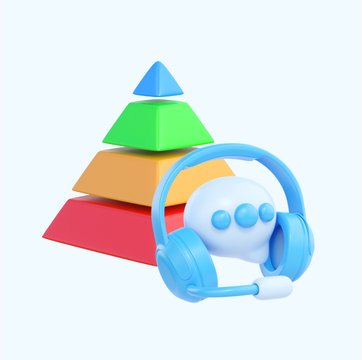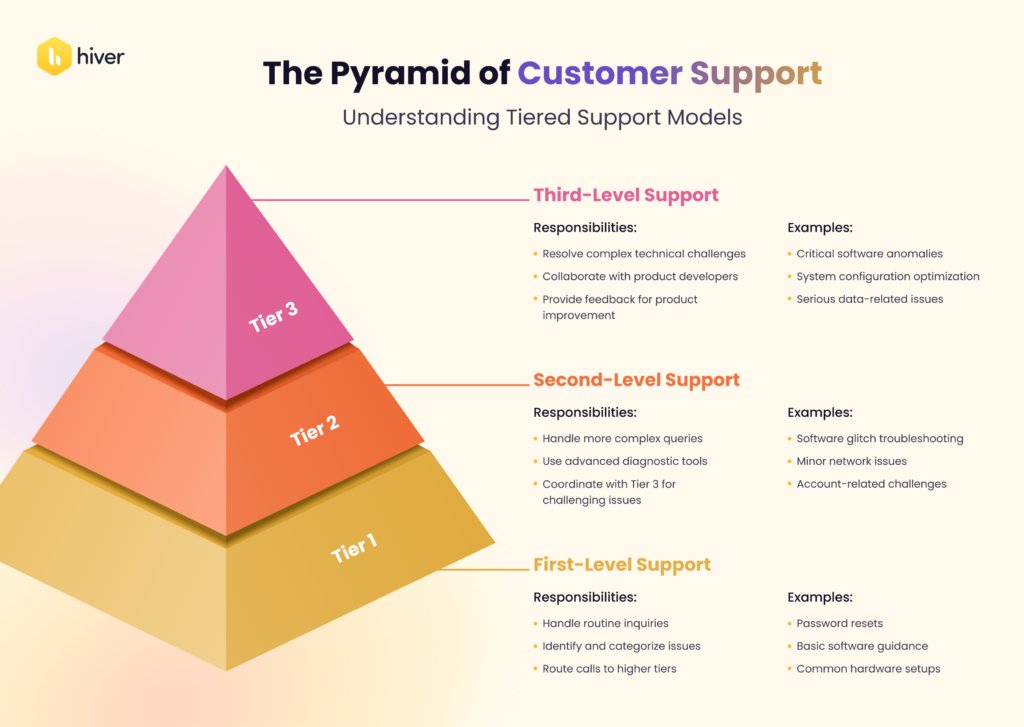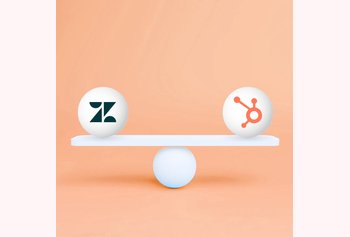Tiered Customer Support Model: A Comprehensive Guide

Table of contents
Customer support teams face various types of queries and complaints. Some of them are quite straightforward, like “How do I reset my password?” and others might be more complex.
At the same time, I’m sure your support team would also have to deal with queries that are more technical and complex. In such instances, it becomes rather challenging for typical frontline agents to resolve such queries – which in turn leads to longer wait times. Plus, you’d want agents of certain expertise to handle certain queries, to speed up resolution time.
This is where the tiered customer support model comes in. It’s like organizing a library: Instead of having all books mixed up, you categorize them so that anyone can easily find what they’re looking for. Similarly, this model sorts customer queries and directs them to the agents best suited to handle them.
In this article, we’ll break down the tiered customer support model. We’ll explore what it is, its benefits, and the steps companies can take to introduce it into their support system.
Table of Contents
- What is the Tiered Support Model?
- Key Components of a Tiered Support Model
- Benefits of Tiered Support Model
- Steps to Implement Tiered Support Model
- Things to Consider When Implementing Tiered Support
- Metrics to Measure the Effectiveness of Tiered Support System
- Final Word
What is the Tiered Support Model?
A tiered support model is a structured approach to customer service, where incoming support requests are categorized and directed to specific levels or “tiers” based on their complexity and the expertise required for resolution.
This method ensures that each query is attended to by the most appropriate team or individual, streamlining the support process and enhancing efficiency.
One essential tool that enables a tiered support model is Hiver. With Hiver, businesses can use shared mailboxes to sort customer emails for different support levels. This makes it easier to manage and answer queries quickly and correctly.
Let’s say a company receives many queries every day about orders, product details, and payment-related issues. Using Hiver, they can set up separate inboxes like ‘Order Questions’, ‘Product Info’, and ‘Payment Issues’.
When a customer sends an email, it goes to the right inbox. So, simple order questions go to the first level of support, and tricky payment problems go to a specialized team. This means faster and more accurate answers for customers.
Key Components of a Tiered Support Model
We’ll be looking at three main tiers of customer support. While companies might have more or fewer levels, having at least three is a good starting point. Let’s go into more detail about these tiers.
1. Tier 1 (First-Level Support):
Often referred to as the “frontline” or “first-level support,” Tier 1 acts as the gatekeeper of the support system. They’re typically the first human point of contact a customer interacts with.
- Responsibilities: Handling routine inquiries, identifying and categorizing issues, directing calls to the appropriate tiers if necessary.
- Examples: Assisting with common tasks like password resets, guiding users on basic functionalities of a software, offering instructions for common hardware setups, or directing users to self-help resources.
2. Tier 2 (Second-Level Support):
One step above Tier 1, these support agents have specialized knowledge that allows them to handle more intricate queries and technical issues that surpass the capacity of first-level support.
- Responsibilities: Handling issues that cannot be resolved by Tier 1, diagnosing issues using advanced tools, and often coordinating with Tier 3 specialists to solve complex challenges.
- Examples: Troubleshooting software glitches that aren’t quite straightforward, rectifying minor network issues, and resolving account-related challenges that might involve deeper system access.
3. Tier 3 (Third-Level Support):
Comprising seasoned experts, Tier 3 is the advanced level of support available. Support agents here are adept at resolving complex technical challenges, often needing to dive deep into systems, codes, or intricate configurations.
- Responsibilities: Conducting in-depth analysis of issues that can’t be resolved by Tier 2, collaborating with product or system developers, recreating and resolving complex bugs, and offering feedback for product improvement based on recurring issues.
- Examples: Debugging critical software anomalies, optimizing system configurations for specialized requirements, or rectifying serious data-related issues that might have broader implications.

Benefits of Tiered Support Model
The tiered support model is highly favored because of the myriad of benefits it offers, such as:
1. Efficient Resource Allocation:
By categorizing support issues based on complexity, businesses can ensure that simpler problems are addressed quickly by the frontline, freeing up specialized agents to tackle more intricate issues.
Basic questions about account settings can be resolved by Tier 1 agents, while critical system bugs are handed over to expert-level Tier 3 agents, ensuring that both types of issues are resolved in optimal timeframes.
2. Improved First-Contact Resolution (FCR):
The model often results in a higher percentage of issues being resolved on the first contact since they’re routed to the best-suited agents from the get-go.
If a user faces a common software glitch, Tier 1, trained in resolving such frequent problems, can offer an immediate solution without unnecessary escalations.
3. Enhanced Customer Satisfaction:
Customers receive support tailored to their specific needs, reducing resolution time and enhancing their overall experience.
For example: A client experiencing a server outage would be immediately escalated to a higher support tier, ensuring they get expert assistance promptly, thus minimizing downtime and potential revenue loss.
4. Streamlined Training:
Training can be tailored to specific tiers, focusing on the depth of knowledge required rather than a broad spectrum of issues.
Tier 1 agents are intensively trained in FAQ-based solutions, while Tier 3 agents undergo rigorous sessions on system architecture and advanced troubleshooting.
5. Clear Career Progression for Agents:
The tiered structure provides a clear pathway for support agents looking to advance in their roles and expertise.
An agent can start in Tier 1, gain experience, receive additional training, and eventually move up to Tier 2 and beyond, helping them feel engaged at work and driving career growth.
6. Better Feedback Loop for Product Development:
Higher-tier agents, dealing with intricate product or service issues, can provide invaluable feedback to development teams, aiding in product refinement.
For instance, if Tier 3 agents continually encounter a specific software bug reported by multiple users, this information can be relayed to the software development team for patching in the next update.
Steps to Implement Tiered Support Model
Implementing a tiered support model is a strategic initiative that can vastly enhance the efficiency and effectiveness of your customer support department. Here’s a step-by-step guide to implementing such a model.
1. Comprehensive Assessment of Your Current System:
To understand the gaps, you need a 360-degree view of your existing support mechanism. This involves a combination of quantitative metrics and qualitative insights.
Steps:
- Data Mining: Dive deep into your support ticket system. Evaluate metrics like average resolution time, ticket backlog, frequency of specific issues, and customer satisfaction scores.
- Feedback Collection: Host focus group discussions or interviews with your support staff. Their on-ground experience can offer invaluable insights into the current challenges and potential solutions.
2. Detailed Definition of the Tiers:
The essence of a tiered support model lies in the way every tier is clearly defined and differentiated from one weather. Doing this requires you to understand the nature of incoming queries and your support team’s structure.
Steps:
- Documentation: Create comprehensive documents detailing each tier’s responsibilities, capabilities, and boundaries. This acts as a reference point for training, recruitment, and process adherence.
3. Strategic Categorization of Issues:
Efficiently matching issues to the correct tier ensures quicker resolutions, smarter resource utilization, and higher customer satisfaction.
Steps:
- Segmentation: Based on the complexity and expertise required, categorize issues and real-time queries into segments. Commonly, frequently asked queries fall into Tier 1, while highly complex, specialized issues might fall into Tier 3 or 4.
4. Resource Optimization and Allocation:
To execute the tiered model efficiently, resources – both human and tech – must be strategically allocated.
Steps:
- Skill Assessment: Evaluate the skills, expertise, and experience of your current support team. Align them with the tier that best matches their abilities.
- Tech Stack Evaluation: Equip each tier with the tools they need. This might include chatbots or FAQs for Tier 1, advanced diagnostic tools for Tier 3, and collaboration tools for inter-tier communication.
5. Tailored Training Programs:
Given the distinct nature of responsibilities across tiers, bespoke training programs are crucial. These ensure every agent is primed to excel in their designated role.
Steps:
- Training Design: Develop tailored modules for each tier. Incorporate both technical training and soft skills, emphasizing nuances of customer interactions.
- Continuous Learning: Introduce refresher courses and new training sessions whenever there’s an update in tools, products, or services.
6. Seamless Escalation Mechanisms:
A hallmark of an effective tiered support model is the effortless transition of issues between tiers, ensuring timely resolutions without redundant efforts.
Steps:
- Criteria Setting: Clearly define the situations or thresholds that trigger an escalation.
- Communication Protocols: Develop standardized procedures for handing over issues, ensuring that all necessary information is transferred efficiently. This could involve shared platforms, detailed documentation, or regular sync-up meetings.
7. Continuous Monitoring and Iteration:
The tiered support model isn’t a ‘set it and forget it’ mechanism. Continuous monitoring, feedback collection, and iteration are crucial to adapt to changing needs and optimizing performance.
Steps:
- Feedback Loops: Encourage both agents and customers to provide feedback. Use this feedback to identify gaps, challenges, and areas of improvement in the tiered support model.
- Model Refinement: Based on the collected data and insights, revisit and refine the model’s structure, resource allocation, or any other aspect as needed.
Things to Consider When Implementing Tiered Support
Implementing a tiered support model is a significant undertaking, demanding careful thought on multiple fronts. Let’s break down the key considerations to bear in mind:
1. Comprehensive Understanding of Customer Needs:
- Insight Generation: Dive into your past support tickets, customer feedback, and analytics to identify the most common issues, challenges, and pain points. Engage with focus group discussions and surveys to grasp the nuanced needs and preferences of your customer base.
- Alignment: Ensure that each tier’s scope is designed around addressing a distinct set of these customer needs, ensuring every potential query has a designated pathway for resolution.
2. Skill Levels and Expertise of Support Staff:
- Mapping Competencies: Assess the current skills, qualifications, and proficiencies of your support staff. Identify who has a general understanding and who possesses deeper, more specialized expertise.
- Role Alignment: Ensure that agents are positioned within the tier that best corresponds to their skills.
3. Analyzing Ticket Volumes and Complexity:
- Data Review: Undertake a detailed analysis of ticket histories. Determine the volume distribution between basic queries and more complex issues. This aids in resource allocation, ensuring adequate staffing for high-volume tiers.
- Forecasting: Use past trends to anticipate future ticket volumes, allowing for proactive adjustments in staffing or resource allocation.
4. Tools, Technology, and Integration:
- Customization: Understand that different tiers may require distinct tools. While Tier 1 might rely heavily on chatbots or ticketing platforms, Tier 3 might necessitate advanced diagnostic tools or technical platforms.
- Seamless Integration: As tickets escalate, it’s crucial that information flows smoothly between tiers. Integrated tools prevent data silos, ensuring continuity in support and a unified customer experience.
5. Establishing Clear Escalation Protocols:
- Procedure Design: Design clear, step-by-step guidelines that detail when, why, and how an issue should be escalated from one tier to the next.
- Communication Channels: Specify channels and platforms for inter-tier communication, ensuring no critical information is lost during handovers.
6. Robust Training and Development Initiatives:
- Tier-specific Curricula: Given the distinct roles of each tier, design training programs tailored to the unique demands of each. This ensures agents are well-prepared and confident.
- Ongoing Development: The business environment, products, services, and technologies evolve. Periodic refresher courses keep agents updated and adept at handling new challenges.
7. Constructive Feedback Mechanisms:
- Two-way Channels: Establish feedback loops where agents can share their on-ground insights and where customers can rate their support experience.
- Iterative Improvements: Regularly analyze feedback to pinpoint areas for improvement.
8. Budgeting and Cost Management:
- Cost Analysis: Different tiers will have varied cost implications, from agent salaries to technology investments. Conduct a detailed cost-benefit analysis, ensuring that the model remains financially sustainable while delivering optimal value.
- ROI Tracking: Monitor the return on investment from the tiered support model in terms of improved customer satisfaction, reduced churn, or increased customer lifetime value.
Metrics to Measure the Effectiveness of Tiered Support System
Measuring the effectiveness of your tiered support system is crucial to ensure that it meets both organizational goals and customer expectations. Here are some of the essential metrics you should consider:
1. First Contact Resolution (FCR):
This metric measures the percentage of tickets resolved during the very first interaction, without needing any escalation. A high FCR usually indicates that Tier 1 support is effective and well-equipped to handle most customer concerns.
2. Average Resolution Time:
This KPI captures the average time taken to resolve a customer issue, from the moment it’s logged to its final resolution. Efficient tiered systems tend to have shorter resolution times, as they direct issues to the most competent agents from the outset.
3. Escalation Rate:
Escalation rate tracks the percentage of tickets that move from a lower tier to a higher one. While some escalation is natural, a very high escalation rate could indicate one of the following:
- Tier 1 support is not sufficiently trained.
- There are major gaps in the product or service offered.
- Customers are facing complex technical issues that need to be fixed at the root level.
4. Customer Satisfaction (CSAT) Score:
CSAT measures the overall satisfaction of customers after their support interaction. It helps gauge the effectiveness of your support tiers and can provide insights into areas that need improvement.
5. Ticket Volume by Tier:
By analyzing the volume of tickets handled by each tier, you can determine if workload distribution is optimal.
6. Agent Utilization Rate:
This metric assesses the percentage of time support agents spend on active problem-solving compared to their idle time. A well-balanced tiered system should optimize agent utilization across all levels.
7. Time-to-Escalation:
This captures the average time taken for a ticket to be escalated from a lower tier to a higher one. Long escalation times can signal bottlenecks in the handover process.
Final Word
A tiered support model can be a game-changer for businesses looking to streamline their customer service. This approach breaks down support into different levels, ensuring that every customer query gets the right attention from the right expert.
The result? Faster solutions and happier customers.
Using tools like Hiver ensures that customer queries don’t get lost in the shuffle and that they get the attention they deserve. In the end, a tiered support model, when paired with effective tools, can greatly boost a business’s customer service quality and efficiency.

































